by Editor | Oct 17, 2011 | Accomodations, Ecotourism, New Articles
By Elena del Valle
Photos by Gary Cox
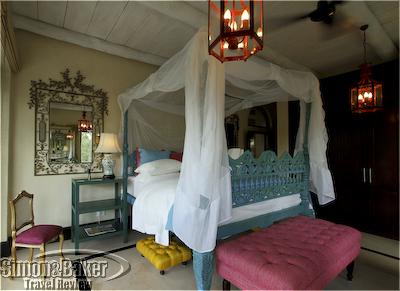
Bedroom at Africa House
From the airport in Johannesburg we flew Federal Air directly to the Thornybush landing strip where Ryan Jack was waiting in an open four by four vehicle to drive us to Africa House, our six room luxury home away from home with a pool for the next four days. We traveled to Africa House, part of the Royal Malewane Reserve which in turn is within the Thornybush Reserve near South Africa’s famed http://simonandbaker.com/kruger, to relax and enjoy the area’s well known game viewing.
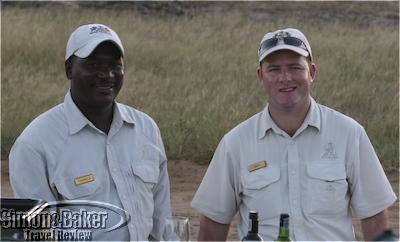
Ryan and Terence
Ryan, our ranger, and Terence Mhlanga would be our companions and guides on twice daily game drives during our visit to this luxury South Africa safari destination. In their company we spent the first and last part of our days, searching for bush experiences, taking thousands of photos and marveling at the flora and fauna of the reserve.
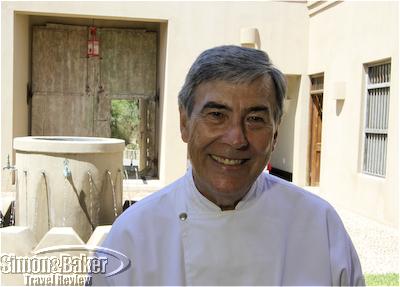
John Jackson
When we arrived at Africa House Ramos, Zama, Gift and John Jackson (see Listen to John Jackson, manager and executive chef, Royal Malewane), the staff, were waiting for us at the entrance. As soon as I saw them I recognized them from our previous stay at the Royal Malewane, an exclusive safari lodge and part of Liz Biden’s The Royal Portfolio, two and a half years earlier. On seeing them the memories of our lovely visit flooded back.
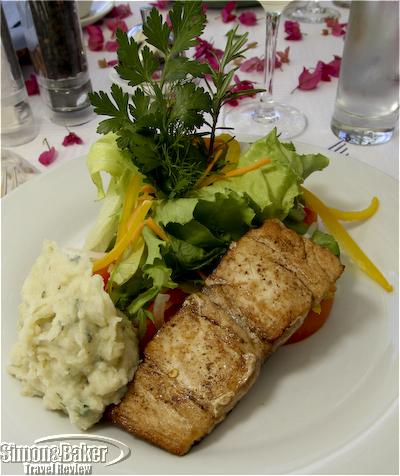
Lunch at Africa House
Moments later John and I were catching up as if time had stood still, walking through the beautiful East Africa entrance door to the stand alone house to settle in our temporary bush home. With John and his team in residence we knew our accommodations and meals would be outstanding. Ryan and Terence ensured our game viewing would be memorable. Our days at Africa House passed quickly and remain etched among our fondest bush stays. We quickly fell into a comfortable routine of early morning and late afternoon game drives with amazing gourmet meals and relaxing quiet private time in between.
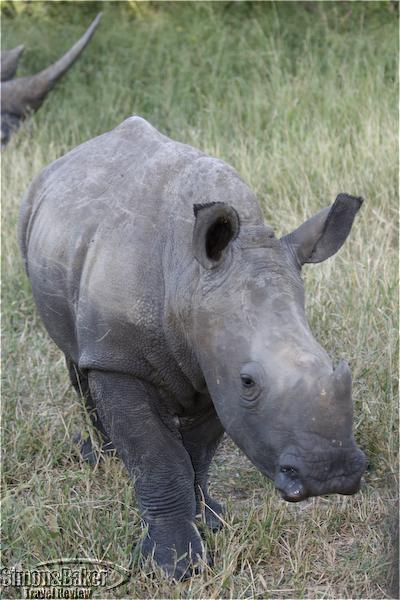
White rhino in Thornybush reserve
Africa House offered a superlative combination of guest centered and attentive service, privacy, at home luxury, gourmet meals and game viewing. It was, in short, one of our favorite safari visit in South Africa. Visit the Simon & Baker Travel Review to read about our Safari Reviews and our stay in Africa House.
by Editor | Oct 10, 2011 | Ecotourism
By Elena del Valle and photos by Gary Cox
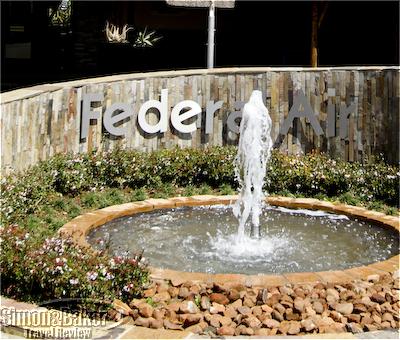
Federal Air at OR Tambo International
In the past when we visited the http://simonandbaker.com/kruger and its environs on safari we flew commercially from Johannesburg to the Kruger Mpumalanga International Airport, rented a car and drove the rest of the way to the safari reserve; or self drove a rental car from Johannesburg to our lodge in or near Kruger. While flying was, in theory, faster it required an early arrival at the airport and the discomforts and safety concerns (including luggage wrapping because of the serious theft problems at the airport) of the Johannesburg airport. And, once we arrived we still faced a drive of two hours or longer to our destination.
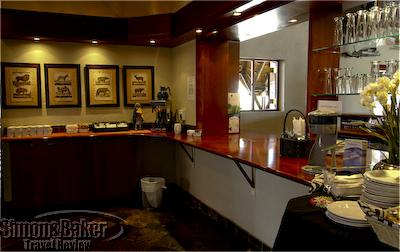
Lounge and snacks at the Federal Air terminal
Self driving from Johannesburg to the safari area in turn meant we were empowered to depart at the time of our choosing and stop as we pleased. However, the drive required a minimum of six hours and the possibility of getting lost. We were also subject to the possible dangers of South African roads. We have unfortunately had a couple of incidents on South African roads (and heard many stories from trustworthy sources) that have made us increasingly wary of driving there.
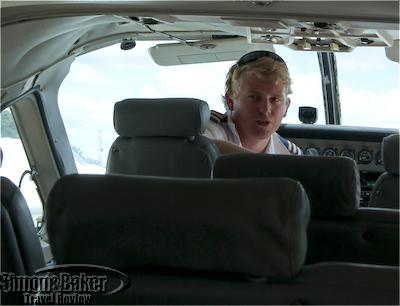
Our pilot does the safety briefing prior to takeoff
On our most recent trip we discovered a great alternative, Federal Air flights from Johannesburg to the nearest landing strip to our safari lodges. Federal Air had its own departure area with a luxury lounge in a separate section of the Johannesburg airport. This meant we could bypass the general traveling population at the airport and spend the time before our flight in relaxed comfort at the Federal Air lounge where there were complimentary snacks and beverages.

Ready for boarding at Royal Malewane airstrip
On arrival at the Thornybush Reserve our ranger was awaiting us at the simple landing strip and within minutes we were settled in at Africa House at Royal Malewane. Likewise, on our return from Singita in the Sabi Sand Reserve our guide drove us to a furnished and comfortable waiting tent stocked with beverages and reading material. Within 10 minutes of our arrival the plane had landed and we were airborne.
by Editor | Sep 12, 2011 | Accomodations, Ecotourism, Food and Wine, New Articles
By Elena del Valle
Photos by Gary Cox and Elena del Valle
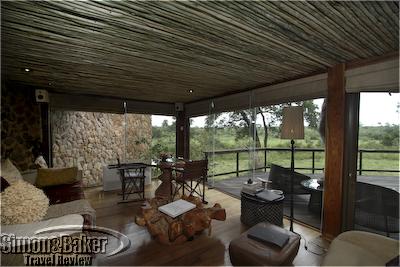
The suite at Boulders featured a stunning view of the bush
We ended our visit to South Africa’s premier game viewing area earlier this year with three nights at the Singita properties in the Sabi Sand Reserve. We spent the first two nights at Singita Ebony and the last night, the first night they were open following a soft refurbishing closure, at Singita Boulders. Our experience was superb.
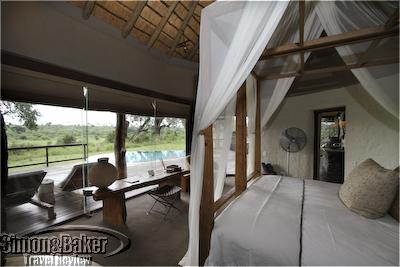
The master bedroom and private pool at Singita Boulders
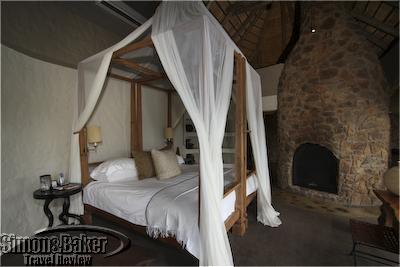
The master bedroom at Boulders featured a wood burning fireplace
At Ebony we enjoyed an informative and fun wine tasting with Francois Rautenbach, the company’s wine manager, in the lodge’s cozy cellar. During the hour long event, shared with four other guests, we heard about South Africa’s varied wine regions and the wines they produce, the evolution of the country’s wine industry and some of the salient wines that are garnering international recognition.
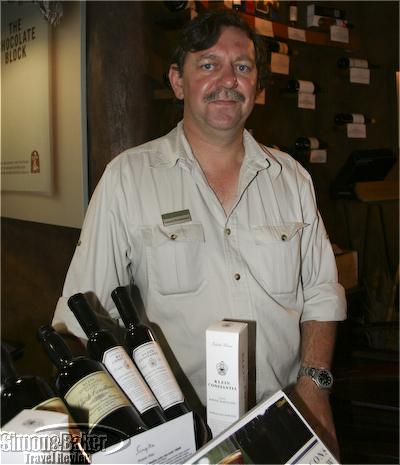
Francois Rautenbach, Singita’s wine manager
During the tasting, we had a chance to sample four wines, selected by the staff, before our tasting menu dinner. We began with a 2008 Director’s Reserve White from Tokara in Simonsberg-Stellenbosch made of 85 percent sauvignon blanc and 15 percent semillon and a 2009 Aeternitas Wines Blanc from Voor-Paardeberg made of 90 chenin blanc, 5 percent viognier and 5 percent grenache blanc.

The Singita shop carried wine and related merchandise
Next we had two 2003 wines, a Sequillo Cellars blend of syrah, mourvedre and grenache from the West Coast and Paarl regions and a Rij’s Private Cellar Bravado blend of 21 percent cabernet, 7 percent cabernet franc, 12 percent merlot, 35 percent shiraz and 25 percent pinotage from the Tulbagh Valley.
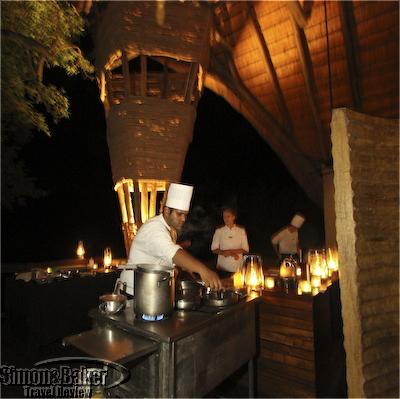
Singita staff prepared an eco-friendly meal by lantern light
At Boulders we joined fellow guests and the lodge staff, at the same time as guests and staff at Singita’s nine lodges in three countries, in an Earth Hour global event organized by the World Wide Fund for Nature on the last Saturday of March every year. The idea is to make it through one hour in the early evening without electricity to raise awareness about climate change.
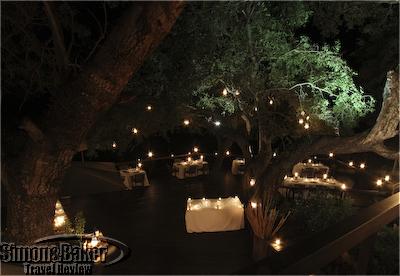
The dining area on the main deck prepared for Earth Hour
The local staff regaled us with a singing and dance performance and the kitchen made sure our dinner, prepared on the deck and served by candlelight was splendid. A company executive and a local news media team were on hand to share the moment with viewers across the country. Visit the Simon & Baker Travel Review for more about Singita Boulders and our visit to the Sabi Sand Reserve and Singita Ebony.
by Editor | Jul 25, 2011 | Accomodations, Ecotourism
Article and photos by Josette King
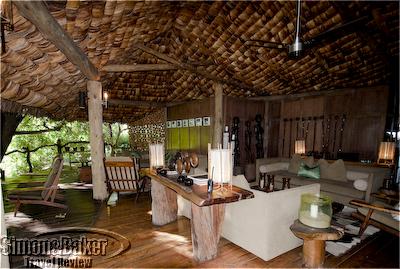
The main lodge at Lake Manyara opens onto a deck
Having enjoyed memorable safari experiences at &Beyond lodges and camps during a previous visit to Southern Africa, I was delighted to include three of their properties in my recent itinerary around Tanzania. All three were located in the Northern Circuit of the country, in the legendary destinations of the Serengeti, Ngorongoro Crater and Lake Manyara. And all three delivered superb guiding, outstanding comfort and attentive service. But then, that is considered de rigueur from any reputable luxury safari organization. So, I asked myself, what is the magic ingredient that makes the &Beyond properties I have stayed at stand out in my mind? There are two actually:
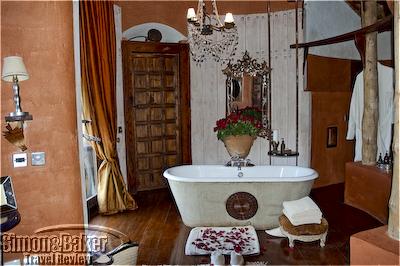
A welcome rose petal bath at Ngorongoro Crater
First, there is Chris Browne, &Beyond’s creative director, the versatile wizard who conjures up for each property an unpredictable and sometimes improbable environment fully integrated within its distinctive surroundings. Each location was a new aesthetic surprise for me with its unique personality but always merely a setting for uncompromising comfort.
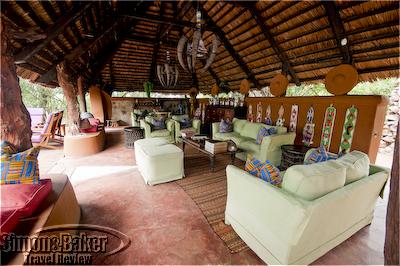
The lounge at Serengeti Grumeti Tented Camp
My first stop of the Northern Circuit was Serengeti Grumeti Tented Camp, in the far northern reaches of the Serengeti National Park. Although just a short drive from the pale grasslands and stark vistas of the “endless plain,” the camp was nestled along the verdant bank of the Grumeti River. To further play on this contrast the décor was an explosion of colors and entertaining details. The lime green sofas of the lounge had vibrant blue and orange pillows that contrasted further with the bright purple market umbrellas and seat cushions of the deck furniture. Whimsical interpretations put a new spin on traditional arts, with light fixtures of fine Masai beadwork and witty polychrome woodcarvings of men in costumes of the colonial era standing guard in a corner of the lounge. It was impossible not to be in a playful mood at this camp.
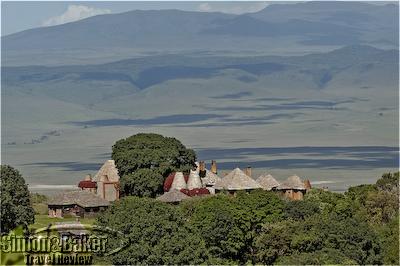
The lodge is perched at the very rim of the Ngorongoro Crater
My next destination was the Ngorongoro Crater Lodge. There, in a fairytale mud and brick village balanced on the very rim of the largest intact caldera on the planet, a Victorian extravaganza awaited, its tongue-in-cheek glamour a perfect foil for the breathtaking scenery below. In generous spaces where rich Zanzibar paneling alternated with whitewashed plaster, miles of raw silk draped soaring French windows, antique mirrors reflected crystal chandeliers, and overstuffed cut velvet sofas were piled with jewel-toned pillows. On 19th century guéridons, urns filled with long-stem roses alternated with fine bronzes of big game and flowing art-nouveau statuettes. Even my bathroom had its own chandelier and Persian carpet!
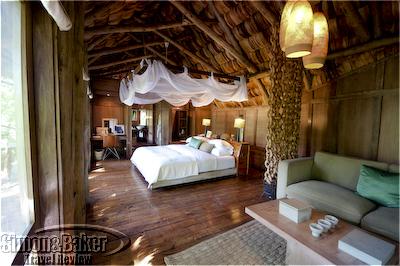
My room at Lake Manyara
The last stop of my journey was Lake Manyara Tree Lodge, a serene retreat tucked in a dense forest of ancient mahoganies, in the foothills of the Rift Valley escarpment, a mere 10 minute drive from the lake shore. Here minimalist luxury prevailed, with clean-lined contemporary furniture and neutral tones. Public areas opened onto a large circular boma (fenced enclosure) with its own brick oven barbecue and central campfire for romantic fireside dinners under the stars. My suite was a genuine tree house, set on a platform perched on stilts high in the boughs of the forest. Screened-in outer partitions opened onto a large veranda that seemed to melt into the forest beyond. I enjoyed eye-level contact with the rich bird-life and the occasional overhead visit of the rarely seen blue monkeys. I couldn’t have wished for a more inspiring environment to bid goodbye to Africa, and relax before the long journey home.
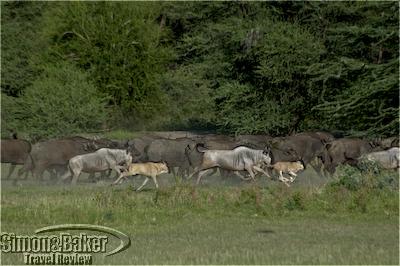
A herd of wildebeests rushes past at Lake Manyara
The second ingredient in the &Beyond magic comes from its multi-level involvement in the local community. Managers told me of priority local hiring of their staff, cross-functional training and internal promotion practices. Young butlers eager to show off their language skills spoke to me of the company-sponsored English lessons; some confided their aspirations to become rangers, and pointed to guides that had started as household staff. At Serengeti Grumeti camp, I had the pleasure to congratulate May Kobero, who after several years in increasing levels of administrative positions, had been officially promoted to the camp’s top job that very morning. I was heartened to find several women in managerial and professional positions (including two women guides at the Crater Lodge). This in turn fosters an enthusiasm and pride in being “&Beyonders” as the staff likes to call themselves that is directly reflected in the quality of service I enjoyed during my stay.
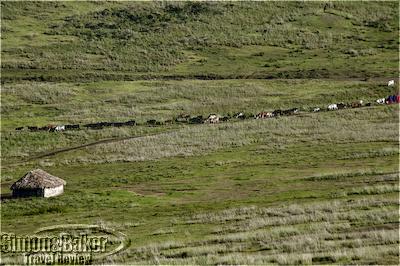
Masai shepherds guide their cattle down the outer edge of the Ngorongoro Crater
Then there is the grass-root level involvement in the community at large: fresh produce purchased from local growers who practice chemical-free farming (from seeds donated by &Beyond), honey from local hives, and the work of local craftspeople integral in the décor of the camps and sold at the camp boutiques. And most importantly, through the &Beyond Foundation, there is the extensive effort to promote literacy in local children. Each property sponsored a school (two of which I had the pleasure to visit) that serves surrounding villages and educates around 600 children. Efforts can range from providing the most basic necessities such as windows, desks and sanitary facilities as well as school supplies, to starting a kindergarten where Masai children can learn Swahili before they enter primary school.
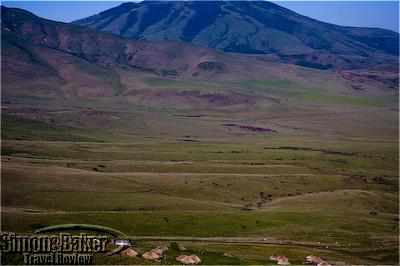
Masai village near the Ngorongoro Crater
There is a special focus on promoting school attendance for girls. Additionally there is an extensive effort on the part of the guides who volunteer their time to educate children on conservation and game protection issues. During the low season they also arrange game drives for the best performing pupils (competition is intense!). And &Beyond encourages Masai adolescents to preserve their cultural heritage. Twice per week during the year a large group of high-school children are bussed from surrounding villages to the Ngorongoro Crater Lodge where they perform their traditional dances and songs for the guests. This is a much sought-after opportunity, as in addition to earning a stipend for their performance, there is an ancillary perk. I noticed a discrete undertone of boys and girls from different villages “checking each other out” throughout the evening.
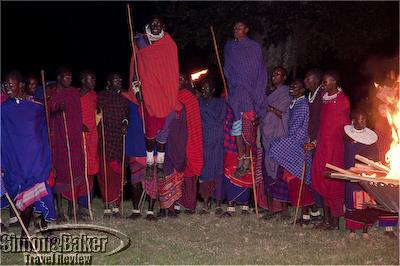
Masai students demonstrate their jumping skills for Crater Lodge guests
It is this multi-faceted combination of aesthetic enjoyment drawn from the luxurious and witty environments created by Chris Browne coupled with the pride and enthusiasm of the staff, as reflected in the superb quality of service, that has made my stay at these properties consistently memorable. As for the for community involvement of &Beyond, it addresses my ever present concern about the impact of luxury tourism on local populations. It enables me to better enjoy the superb accommodations and hospitality of the properties, knowing that my visit contributes, however modestly, to providing growth opportunities to the local population while helping preserve their culture and natural environment.
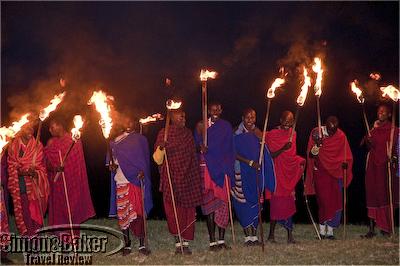
Masai students share their traditional dances with Crater Lodge guests
Visit the Simon & Baker Travel Review to read more about my visit to Tanzania, Serengeti Grumeti Tented Camp, Ngorongoro Crater Lodge and Lake Manyara Tree Lodge.
by Editor | May 23, 2011 | Ecotourism
By Chester Godsy
Photos by Chester Godsy and Joni Johnson-Godsy
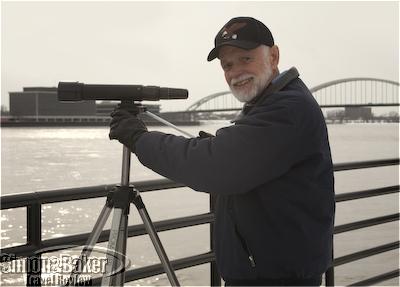
Bob Motz of Bald Eagle Safaris
While visiting the Quad Cities we met with naturalist Bob Motz who offers local Bald Eagle Safaris. Bob filled us in on many of the interesting facts about eagles on our drive to an eagle viewing location. He told us he had a number of locations where he would take customers depending on their interests. Our interest on this trip was to get some pictures of eagles and to stay out of the cold weather as much as possible as temperatures were below 0 degrees Fahrenheit.
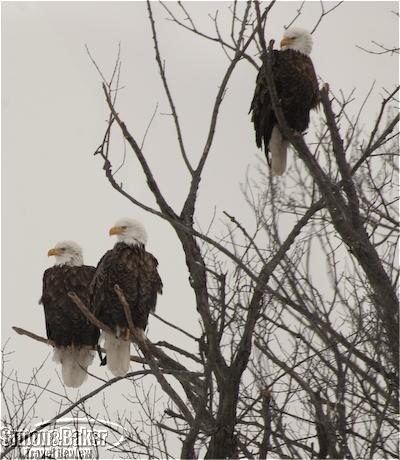
Eagles roosting
Bob provided us with some top notch spotting scopes that would go from x15 to x45 magnification and a training session on how to use them. When we arrived at the location he had selected we saw, spread across numerous trees, about two dozen eagles. There was a mixture of fully mature eagles (these could be identified by their white heads) and juvenile eagles (under five years of age). We watched the eagles with the spotting scopes and took pictures from the warmth of Bob’s car. We were between 25 and 75 yards from the eagles at all times.
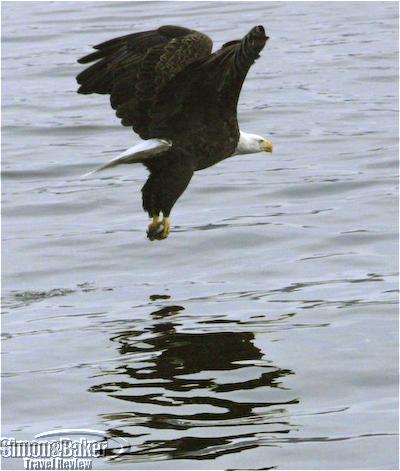
Eagle in flight
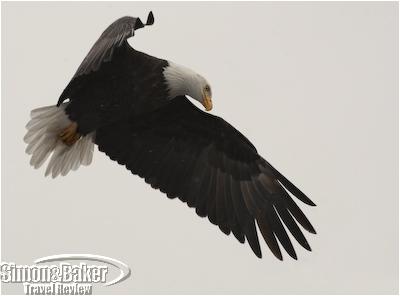
Coming in for a landing
On more than one occasion I had an eagle in full view with a spotting scope where I could clearly see the yellow eye of the eagle blinking. After our time with Bob we were really glad we started our eagle viewing with Bob’s Eagle Safaris (Eagle Safaris by Bob Motz, 2535 River Heights Drive, Rock Island, Illinois 61201, +1 (309) 788-8389, eaglemotz@aol.com) because of all we learned about the eagles before setting off to try eagle viewing by ourselves.
by Editor | Dec 6, 2010 | Attractions, Ecotourism, New Articles
Article and photos by Elena del Valle

A young boy in a tiny boat floats through the village
During a recent trip to Siem Reap, Cambodia I had an opportunity to spend time in a conservation area and bird reserve near the city. Although the conservation area we visited was only 90 minutes by car and boat from the central urban area where my hotel was it was vastly different from the hustle and bustle of the city. Spending time in an area visited by only 150 bird and conservation enthusiasts a year was special. As the word spreads about the eight conservation areas that it is possible to visit in Cambodia and tourism to the region continues to grow the number of visitors to the reserve will likely grow as well. For now, it is still a pleasure of serene lake and birding panoramas.
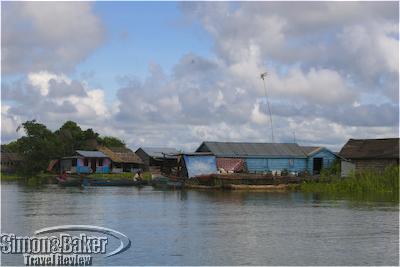
Most of the village floated on the water
Nick Butler, the coordinator of the Sam Veasna Center for Wildlife Conservation, and Sophoan Sanh, a senior tour guide with five years of experience with the Center, escorted me on a day long Bird Reserve and Floating Village Day Trip on Tonle Sap Lake. To take advantage of the weather and avoid rain as much as possible we set out at 6 a.m. on a weekday morning. We drove from my hotel in central Siem Reap through the countryside to the shores of Tonle Sap Lake, the home of, and an important source of livelihood for, many Cambodians; where we boarded a 10 meter wood motorboat with a 110 horsepower engine, curtains (in case of rain) and an upper deck (we were quite thankful for the curtains and cover when it rained) to traverse the lake in a west southwest direction to our destination, the Prek Toal Bird Sancuary and the nearby village of Prek Toal.
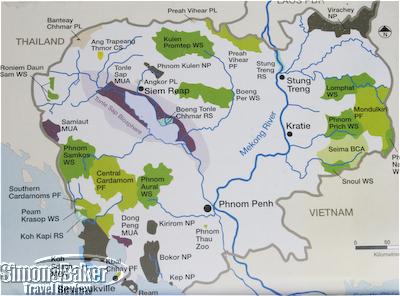
Map of Cambodia
Along the way Nick, a native of the United Kingdom, and Sophoan, a Cambodian, shared information about the lake and its importance for the local communities, the birds in the area and the environment while we munched on the goodies from the breakfast boxes they had brought along. Although there was plenty of space in the shady comfort of the boat we climbed onto the upper deck to better view the lake and the birds. On our way through the conservation area to one of the main floating villages we stopped at an observation point, a tree where Center staff spent time to monitor and protect the bird nesting areas (sometimes the fishermen were drawn to them because of the excellent fishing they offered). From the canopy of the tree we could see for miles around the lake, including approaching rain clouds. It was a beautiful sight. Although there was a seemingly infinite variety of insects that rained on us when we brushed the trees as we motored around the reserve I saw not a single mosquito and for that I was thankful.
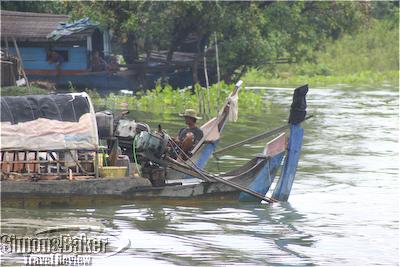
Boats of many descriptions were the core of local transport
At the Prek Toal floating village we picked up a representative of the Cambodian parks and made a restroom stop (although there was a toilet on the boat it was tiny and without toilet paper) before heading to a local house for lunch. The village was a lively place with residents going about their everyday lives in their floating homes and businesses or making their way from one location to another by boat. Lunch, prepared by a village family who had received special training, was delicious.
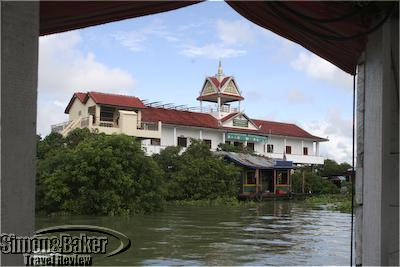
A non floating temple in the floating village
After lunch, a teenage member of the family showed us around the village in a small rowboat. I particularly enjoyed the water level view we had on the boat that allowed us to see the inhabitants, their homes and businesses close up. Some came to their door to look at us with curiosity; at times children waived shyly and adults smiled when we waved back. After that we crossed the lake to reach our car for the short drive back to Siem Reap, arriving at my hotel in the late afternoon. The day trip remains one of my favorite memories of Cambodia.
Visit Simonandbaker.com for additional information about Siem Reap and my tour with the Sam Veasna Center for Wildlife Conservation.










































